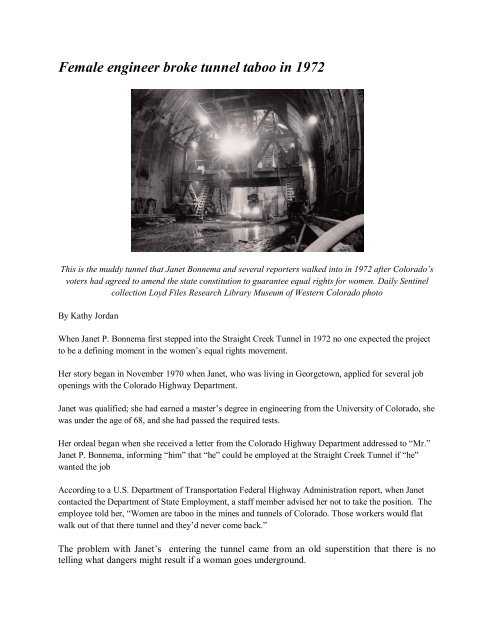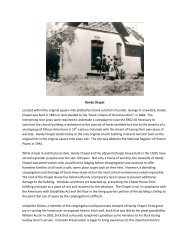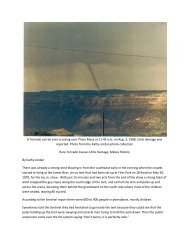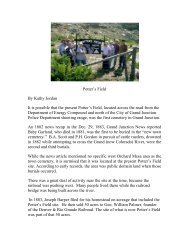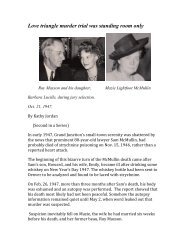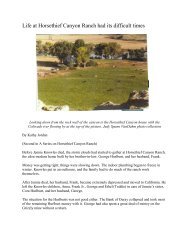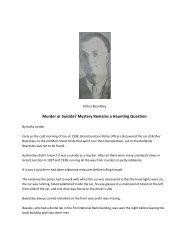Female engineer broke tunnel taboo in 1972
Female engineer broke tunnel taboo in 1972
Female engineer broke tunnel taboo in 1972
You also want an ePaper? Increase the reach of your titles
YUMPU automatically turns print PDFs into web optimized ePapers that Google loves.
<strong>Female</strong> <strong>eng<strong>in</strong>eer</strong> <strong>broke</strong> <strong>tunnel</strong> <strong>taboo</strong> <strong>in</strong> <strong>1972</strong><br />
This is the muddy <strong>tunnel</strong> that Janet Bonnema and several reporters walked <strong>in</strong>to <strong>in</strong> <strong>1972</strong> after Colorado’s<br />
voters had agreed to amend the state constitution to guarantee equal rights for women. Daily Sent<strong>in</strong>el<br />
collection Loyd Files Research Library Museum of Western Colorado photo<br />
By Kathy Jordan<br />
When Janet P. Bonnema first stepped <strong>in</strong>to the Straight Creek Tunnel <strong>in</strong> <strong>1972</strong> no one expected the project<br />
to be a def<strong>in</strong><strong>in</strong>g moment <strong>in</strong> the women’s equal rights movement.<br />
Her story began <strong>in</strong> November 1970 when Janet, who was liv<strong>in</strong>g <strong>in</strong> Georgetown, applied for several job<br />
open<strong>in</strong>gs with the Colorado Highway Department.<br />
Janet was qualified; she had earned a master’s degree <strong>in</strong> <strong>eng<strong>in</strong>eer</strong><strong>in</strong>g from the University of Colorado, she<br />
was under the age of 68, and she had passed the required tests.<br />
Her ordeal began when she received a letter from the Colorado Highway Department addressed to “Mr.”<br />
Janet P. Bonnema, <strong>in</strong>form<strong>in</strong>g “him” that “he” could be employed at the Straight Creek Tunnel if “he”<br />
wanted the job<br />
Accord<strong>in</strong>g to a U.S. Department of Transportation Federal Highway Adm<strong>in</strong>istration report, when Janet<br />
contacted the Department of State Employment, a staff member advised her not to take the position. The<br />
employee told her, “Women are <strong>taboo</strong> <strong>in</strong> the m<strong>in</strong>es and <strong>tunnel</strong>s of Colorado. Those workers would flat<br />
walk out of that there <strong>tunnel</strong> and they’d never come back.”<br />
The problem with Janet’s enter<strong>in</strong>g the <strong>tunnel</strong> came from an old superstition that there is no<br />
tell<strong>in</strong>g what dangers might result if a woman goes underground.
But Janet went to work for the Colorado Highway Department on the project and worked for 18<br />
months without ever sett<strong>in</strong>g foot <strong>in</strong> the burgeon<strong>in</strong>g <strong>tunnel</strong>. Colorado Highway Department<br />
officials admitted that Janet was qualified for the job was and was “do<strong>in</strong>g a great job up there”<br />
but said the contractor wouldn’t let any women, not even female reporters, <strong>in</strong> the <strong>tunnel</strong>.<br />
However, because she was not allowed <strong>in</strong> the passage, she could not do her job, which was to plot data<br />
gathered from <strong>in</strong>struments <strong>in</strong>side the <strong>tunnel</strong>. She had to depend on her male counterparts to gather the<br />
<strong>in</strong>formation <strong>in</strong>side the <strong>tunnel</strong> for her.<br />
She soon figured “I’d be a lot more useful if I could get the data firsthand, the way male technicians do.”<br />
She was quoted by the Federal Highway Adm<strong>in</strong>istration as say<strong>in</strong>g, “I am not allowed to do the same work<br />
as the male <strong>eng<strong>in</strong>eer</strong><strong>in</strong>g technicians, even though I am physically able, <strong>in</strong> better condition and have more<br />
stam<strong>in</strong>a than many of the male <strong>eng<strong>in</strong>eer</strong><strong>in</strong>g technicians.”<br />
Janet was physically able. She frequently climbed mounta<strong>in</strong>s, rode her motorcycle daily to work at the<br />
<strong>tunnel</strong>, was an airplane pilot, and had been capta<strong>in</strong> of the University of Colorado ski team.<br />
Janet didn’t th<strong>in</strong>k that superstition aga<strong>in</strong>st women enter<strong>in</strong>g <strong>tunnel</strong>s was a legal reason for her not to do her<br />
job.<br />
In July <strong>1972</strong> the United States Department of Transportation, after a yearlong <strong>in</strong>vestigation, ruled that the<br />
old wives’ tale was not a legal reason to bar women from the <strong>tunnel</strong> and to do so was to practice sex<br />
discrim<strong>in</strong>ation.<br />
But the Colorado Department of Highways ignored the rul<strong>in</strong>g. Janet filed a $100,000 class action lawsuit<br />
charg<strong>in</strong>g that, <strong>in</strong> addition to not be<strong>in</strong>g allowed to gather the data first hand, she was be<strong>in</strong>g denied<br />
irreplaceable experience at what her lawsuit called “a unique and highly important <strong>eng<strong>in</strong>eer</strong><strong>in</strong>g project.”<br />
The suit was settled out of court. When Janet filed her lawsuit, she jo<strong>in</strong>ed a new class of women, mostly<br />
whitecollar workers, who were seek<strong>in</strong>g jobs where men didn’t welcome them.<br />
On Nov. 9, <strong>1972</strong>, Janet strolled <strong>in</strong>to the <strong>tunnel</strong> after Colorado’s voters had agreed to amend the state<br />
constitution to guarantee equal rights for women. As Janet and several women reporters walked <strong>in</strong>to the<br />
<strong>tunnel</strong> a workman shouted “Get those women out of here,” and more than 70 workmen walked off the<br />
job.<br />
One worker quit on the spot say<strong>in</strong>g, “they had a woman <strong>in</strong> the <strong>tunnel</strong>, and I will not work there for that<br />
reason. It’s a j<strong>in</strong>x.”<br />
Janet paid no attention as she slogged through the mud.<br />
The state estimated that the walkout cost about $10,000, but, as some observers had predicted, the men<br />
returned the next day to complete the job.
Janet died May 9, 2008, <strong>in</strong> Okeechobee, Fla. She was <strong>in</strong>ducted <strong>in</strong>to Colorado Women’s Hall of Fame as<br />
a transportation <strong>eng<strong>in</strong>eer</strong> <strong>in</strong> November 2011.<br />
On April 6, 2011, Colorado State Senator Nancy Spence honored Janet’s memory on the Senate floor,<br />
say<strong>in</strong>g “without her will<strong>in</strong>gness to stand up to discrim<strong>in</strong>ation, generations of women would never have<br />
the opportunities they do today.”<br />
This is a sidebar:<br />
An <strong>in</strong>terest<strong>in</strong>g <strong>tunnel</strong> tidbit: The first driver was not Gov. John Love as planned. Marion Wooldridge<br />
made history when he was out for a drive, after dr<strong>in</strong>k<strong>in</strong>g a little too much, and drove past the sign<br />
prohibit<strong>in</strong>g traffic. When he went to court Judge George Gaubatz of Clear Creek County Court dismissed<br />
the charge on the grounds that the signs prohibit<strong>in</strong>g traffic at the <strong>tunnel</strong> entrance weren’t adequate.


